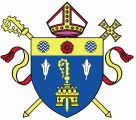The rapid growth of Wesham from around 1840 onwards, primarily due to the construction of the railway and the development of cotton mills and housing for workers, drove the need for a catholic church in Wesham.
The building of the church of St Joseph’s at Wesham was instigated by Father Hines of The Willows, who had already overseen the construction of St Anne’s at Westby, as well as many other extensive works.
The Billington family of Kirkham, who had also given freely to The Willows and St Anne’s, were the main contributors of funding for construction. The Rev. Thomas Billington and his sister Mrs. Ann Gibson both died in 1880, and both left money towards the new church; the former £742 and the latter the large sum of £5,270 making a total of £6,012.
The site of the church at Wesham Cross, where formerly an ancient cross had stood at the crossroads, was bought from Lord Derby. Here, at the end of the lane leading to Mowbreck Hall, where the mission had begun, a church and presbytery were built at a contract cost of £4,070. However, so many extras were added that the final cost was over £6,000. The people of Wesham contributed what they could, especially towards the cost of furnishing the church; many bought benches, while others helped to pay for vestments, stained glass, candlesticks, and the like.
The foundation stone of the new church was laid on July 13 1884 by Bishop O’Reilly of Liverpool, in a ceremony preceded by a long procession from the Willows organised by the Catholic Brethren, and involving hundreds of children and many confraternities with banners and bands. Nearly two years later the church, dedicated to St. Joseph, and with accommodation for up to five hundred people, was completed. It was consecrated on Thursday March 18 1886, opening on the following Sunday, by the Bishop of Leeds in the presence of Bishop O’Reilly, a host of clergy, and a large congregation. In the afternoon Father Bilsborrow, later Bishop of Salford, preached an eloquent sermon. Himself a native of the Fylde, being born at Singleton, he spoke of the contribution made during penal times by the Catholics of Lancashire to the survival of the faith in England. “Lancashire”, he said, “was the backbone of Catholicity in England in those days as it is now and the Fylde was the backbone – the cream – of Catholicity in Lancashire.”
The first Parish Priest of St. Joseph’s was Father W Wrennall, D.D., who came from Ushaw. Under his direction a school was built in 1890, and a cemetery consecrated in 1895.
In November 2011, St Joseph’s became linked with The Willows, the Parish Priest of The Willows serving both parishes.
On the 21st July 2013, the parishes of The Willows and St Joseph’s merged to form a single parish, The Holy Cross, named after the original chapel at Mowbreck Hall, from which they had both originated.

